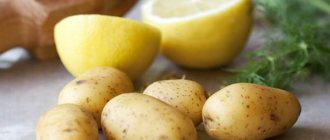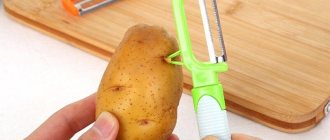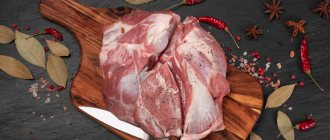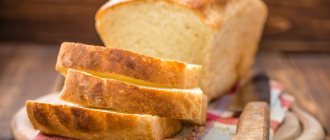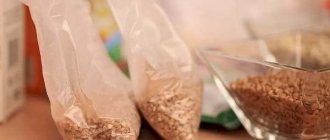The potatoes are not boiling, what should I do? How not to overcook potatoes
Boiled potatoes are one of the tasty and satisfying side dishes. This is an excellent addition to fried chicken, pork, mushrooms, and fish. It is prepared quite simply and quickly. However, to prevent the potatoes from turning into puree during cooking, it is necessary to take into account several nuances.
Choose your recipe
1
For boiled potatoes, choose pink or yellow varieties. They are more difficult to boil than vegetables with white tubers.
2
Take tubers of the same size. Or cut large potatoes into several pieces so that the vegetables cook evenly.
3
It is better to salt the potatoes at the beginning of cooking. Salt will prevent the vegetables from boiling. Also, before putting the tubers in the water, pierce them with a knife.
4
Potatoes are difficult to boil in a slightly acidic environment. Therefore, you can add a little vinegar, a few slices of pickled cucumber or a slice of lemon to a pan of boiling water. Don’t worry, the dish will not acquire any sour taste. When preparing soup, potatoes should be dipped into the broth along with vegetables containing acid, such as cabbage or tomatoes.
5
Cook the potatoes over moderate heat. If the flame is strong, the outside will quickly boil, but the inside will remain raw.
6
To prevent the potatoes from overcooking, there is such a trick. Wait for the pan with vegetables to boil. Pour off some hot water and add cold water instead. Or another way - let the potatoes simmer for 15 minutes. Then drain 2/3 of the water and steam the dish under a closed lid.
7
Most of the vitamins and minerals in potatoes are found under the skin. And in order not to throw away useful substances in the trash, it is recommended to boil the tubers in their uniforms. Before cooking, they must be rinsed well under running water and pierced in several places with a needle. This will prevent the potatoes from boiling.
8
It is recommended to immerse peeled potatoes in boiling water, not cold. This way vegetables retain more vitamins and minerals. You can also put a few cloves of garlic, a couple of black peppercorns, bay leaves or herbs into the pan with potatoes. This will significantly improve the taste of the dish.
9
Boiled potatoes are incredibly tasty using the following recipe. Peel and rinse young medium-sized tubers. Pour water into an enamel pan, boil and add salt. Lower the vegetables and simmer over medium-low heat for 10 minutes.
10
Then drain the water and fill the potatoes with milk at room temperature instead. Reduce heat to low and continue cooking until done. To prevent the milk from burning to the bottom of the pan, you need to shake it from time to time. Place the finished treat on a plate, add butter and sprinkle with herbs. Serve as a separate dish or as a side dish.
Add citric acid
In principle, it does not matter what means you use to make the water for boiling potatoes sour. The main thing is that it does not harm your health. In the absence of vinegar and lemon, I use citric acid from the pack. When cooking, I add 1 teaspoon of powder at a steady rate. The result is always pleasing - the tubers are perfectly smooth and well-cooked.
We recommend: How to chop cabbage thinly and very quickly: choosing the best tool
Why are the potatoes in the soup hard? Why are potatoes hard when cooked?
The markets are already selling new potatoes in full swing, and this year’s batches are also appearing in stores. How not to make a mistake?
Look into the tuber
If you are buying potatoes for winter storage, it is better to choose not just one variety, but at least 2-3. This will make it more likely that some will last until spring, and in addition, your supplies will have potatoes for various culinary purposes. Potato varieties differ in purpose. And it is important to know their characteristics. But often they simply write the ingredients on the label.
+ Starch content above 15% - the variety is suitable for purees. The puree will be tender and fluffy, although very high in calories. Varieties: Golubizna, Lorch, Sineglazka, Lugovskoy, Adretta, Elizaveta.
+ Below 15% - for soup and salad. Such tubers do not fall apart when cooked, low-calorie: Leader, Krasavchik, Alvara, Red Scarlett, Nevsky, Udacha, Nikulinsky. And the Gourmet variety, with dark blue flesh and a high content of antioxidants, is suitable for salads. It can even be eaten fresh.
+ Dry matter - no less than 20-24%, and reducing sugars - no more than 0.5% - such potatoes can be fried, they will not crumble in a frying pan or in a deep fryer, will not acquire a bitter taste and will not darken. These varieties have the ability to “keep” starch from breaking down into sugars. Thanks to this property, potato slices retain their shape when fried. Varieties: Leader, Nadezhda, Kolobok, Bryansky early, Zhukovsky early, Impala, Felox.
ON A NOTE
When cooking mashed potatoes, it is better to put the tubers in boiling water, and for salad - in cold water. Until the water boils, some of the starch will be washed out of the “salad” potatoes, and they will not crumble.
Unwashed potatoes make the choice easier
The best domestic potatoes grow in the Lipetsk, Voronezh, Kursk, Tambov, Tver regions, and in the Moscow region. Potatoes do not like heat, which reduces the quality of the tubers. Potatoes brought from the Bryansk, Leningrad regions and from the north of Ryazan need to be chosen more pickily. In these regions there are both good and not quite suitable soils for potatoes, which produce a product of not the best quality.
If you buy unwashed potatoes (the kind that are best suited for long-term storage), consider that you have a trump card: thanks to the soil sticking to the tubers, you can understand how the potatoes will be stored and how tasty they will be.
+ The worst option is sand (hard grains of sand can be felt). On sand, the tuber is “liquid”; it is poorly stored and darkens when cooked.
+ Potatoes from peat bogs can suffer from the same shortcomings if they have been poorly cared for, but still to a lesser extent. Peat can be recognized by its deep black color; when it dries, it hardly brightens, crumbles, and is present mainly in the form of dust on potato skins.
+ It is easiest to grow good potatoes on black soil and loam. If you see a potato with black, gray or brownish plastic “dirt” stuck to the tubers, take it boldly.
BY THE WAY
Why do potatoes turn dark when cooked?
Unfortunately, it is impossible to determine whether the tubers will darken during cooking when buying potatoes. This happens due to improper storage, careless harvesting - when potatoes are beaten during harvesting, or when there is an excess of nitrogen fertilizers in the soil. In fact, all modern varieties are relatively resistant to this scourge, but still do not guarantee a solution to the problem. Lorch, Krasavchik, Golubizna, and Nikulinsky are the best at maintaining an “unblemished reputation” than others.
IMPORTANT
Signs of a good potato
1. Choose larger tubers. As a rule, they have time to ripen better, that is, they taste better and contain more vitamins.
2. Tubers are dense and hard.
3. The peel is smooth and without roughness or dark spots.
4. Eyes - clean, shallow, without a dark halo (a sign of rotting)
5. Potatoes do not crack or split when cut.
Secrets of cooking potatoes
Did you know that you can reduce the cooking time for potatoes? While cooking root vegetables, add 20-25 g of oil. The method will increase the heat capacity of water, which will reduce the time. This way you will also improve the taste of the potatoes.
Everyone says that the best seasonings for potatoes are green onions and dill. But at least once, replace these ingredients with rosemary. A little dried rosemary will add a great aroma and taste.
You can also “mix” seasonings. For example, garlic with coriander, cumin or black pepper, etc.
Features of potato varieties
The ideal varieties for preparing jacket potatoes are those from group A:
- Lighthouse.
- Sturdy.
- Anniversary of Zhukov.
- Sturdy;
- Annushka;
- Dolphin.
They have dense flesh, not watery or mealy. The potatoes are not boiled. When finished, it cuts perfectly. The pulp does not become dark after heat treatment.
The potatoes dissolved in the water. How to store peeled potatoes for dishes
To prepare, select and wash the required number of tubers. Remove the peel with a knife or potato peeler, cut out the eyes and other damage. Peel young tubers very delicately, removing only the thinnest layer of peel. Old potatoes should be peeled more thoroughly, capturing part of the tuber along with the peel. If during the cleaning process green areas of the tuber are found, then the potatoes should be discarded.
Now you can proceed directly to storage. Let's look at four universal methods that will help you prepare potatoes for a wide variety of dishes for up to two days.
| in water at room temperature | 2–4 hours | + | + | + | + |
| in water in the refrigerator | 24–48 hours | + | + | – | + |
| in a bag in the freezer | up to 24 hours | – | – | + | – |
| in film in the freezer | up to 24 hours | + | + | – | + |
Potatoes boiled in a saucepan for mashing
To prepare mashed potatoes, it is better to use crumbly varieties of mature potatoes, although others are quite suitable for this dish. The preparation is usual - the potatoes are washed, peeled and cut into pieces. You can boil the whole tubers, but it will take more time.
Preparation:
- Place well-washed and peeled potatoes in a saucepan with cold water and put on fire.
- As soon as the water boils, add salt, bay leaf and a pea of allspice - all this will make the puree fragrant.
- Small potato pieces only need 15 minutes to cook. It is necessary to drain the water and remove the pepper and bay leaves.
- Put butter, a little hot boiled milk into the potatoes and mash well.
The benefits and harms of cooked potato dishes
The composition of 100 g of potatoes, in addition to starch, includes:
- 2.9 g of proteins (3.54% of the daily value);
- 0.1 g fat (0.15% of normal);
- 13.9 g carbohydrates (10.86%);
- 3.3 g of dietary fiber (16.5%) (prevents constipation, promotes the removal of cholesterol);
- 77.8 g (3.04%).
Potatoes contain nutrients:
- Calcium. Stabilizes the functioning of the cardiovascular system and central nervous system. Regulates vascular tone. Helps strengthen cell membranes. Takes part in the formation of dentin and tooth enamel. Provides bone strength (including cartilage tissue).
- Sodium. Normalizes water-salt balance and neuromuscular activity. Activates enzymes of the pancreas and salivary glands. Has a vasodilating effect. Keeps minerals in the blood in a soluble state.
- Phosphorus. Increases the absorption of nutrients and other vitamins. Improves the condition of bones and teeth. Without it, normal muscle functioning is impossible, and mental activity deteriorates.
- Copper. Regulates blood pressure and reduces pain. Normalizes metabolism and the functioning of the endocrine system. Relieves inflammation, reduces elevated body temperature. Calms, improves sleep. Provides support to joints and bones, keeping their calcium content at the required level. Takes part in the synthesis of hemoglobin.
- Manganese. Regulates blood glucose levels. Reduces the level of “bad” cholesterol and slows down the growth of cholesterol plaques. Supports bone health. Promotes rapid healing of wounds.
- Iron. Synthesizes hemoglobin, improves thyroid function. Relieves fatigue and fatigue. Reduces abdominal pain during menstruation. Normalizes blood sugar levels (if the level is elevated).
- Zinc. Immunostimulant. Reduces the duration of colds. Supports healthy skin and mucous membranes. Accelerates wound healing.
Vitamin C restores the natural internal environment and normalizes oxidative processes. Ascorbic acid strengthens the immune system and activates defenses. Vitamin C makes blood vessels more elastic and stronger. It normalizes the functioning of the nervous system, heart, blood vessels;
Potatoes contain 1/6 of the daily potassium requirement. It regulates the acid-base balance of the blood, normalizes blood pressure and kidney excretory function. Necessary for the full transmission of nerve impulses.
Antioxidants soften the negative effects of ultraviolet radiation and normalize metabolism. Resists free radicals.
Folates normalize the functioning of the central nervous system and reduce cholesterol levels. Folic acid increases the efficiency of the liver. Synthesize red blood cells. Restores cells.
Potatoes also contain B vitamins. They help cope with stress and increased emotional stress. Normalizes the functioning of the cardiovascular system. Improves intestinal function. Microelements strengthen the immune system and increase the body's resistance to diseases.
Of course, heat treatment reduces the value of potatoes.
Contraindications for use of the product
Potatoes are harmful because they contain solanine, a substance that can cause poisoning. To avoid negative consequences, do not eat green or sprouted tubers.
The product is contraindicated for people with problems:
- gastrointestinal diseases;
- diabetes mellitus;
- obesity;
- reduced stomach acidity.
People who are allergic to starch should also exclude potatoes from the menu.
Boil potatoes with skins on for easy peeling
It often happens that boiled potatoes with skins are difficult to peel. But there is one simple secret that you can use to clean the tubers. Immediately before cooking, thoroughly wash the tubers. Then use a sharp knife to make a shallow cut around the potato and through the top.
In this form, place the vegetable in a pan and fill it with water so that it is 2 cm higher. Cook until done. Then immediately transfer the tubers to cold water to cool. Once the water is warm, peel the skins off the potatoes with a gentle movement of your fingers. You can do this directly in the pan.
Potatoes boiled in their jackets in a slow cooker
If potatoes are cooked incorrectly and for a long time using the boiling method, the vegetable loses a lot of useful substances. To avoid this, you can use a slow cooker. Thanks to it, it will be possible to maintain the integrity of the tubers, they will be easily peeled and will retain their shape when cut.
Wash the required number of tubers thoroughly. Place the potatoes in the bowl of the device and add salt. Pour water so that the vegetable is covered by no more than 2 mm. Close the multicooker lid and select the “Steam” program or similar. When finished cooking, drain the water.
If you have never cooked potatoes in a slow cooker before, then for the first time choose a maximum time of 20 minutes for cooking. Then check readiness, and if necessary, increase the time by another 10-15 minutes.
How many kilograms do you want to lose?
Choose how many pounds you want to lose and get a nutrition plan to achieve the desired result.
1-5 kg 5-10 kg 10-15 kg 15-20 kg 20-25 kg 25-30 kg
Tips and Tricks
If potatoes boiled in their jackets will be used for salad, then preference should be given to early and medium varieties with a low starch content. The most rich in taste of them will be: Rossiyanka, Kalinka, Effect, Sante, Adretta, Ilyinsky and Detskoselsky.
Potatoes that have already begun to sprout or have developed long roots are not suitable for boiling in their jackets. Tubers should be selected that are dense, without visible blackening or dark spots. If potatoes with a high starch content are used for okroshka or salads, then during cooking it is necessary to add vinegar to the water (1 tbsp per 1 liter). This will prevent the tubers from boiling.
Before cooking, be sure to wash the potatoes well in plenty of water. If it is too dirty, use a stiff brush. It is not recommended to leave the vegetable after boiling over high heat. Otherwise, the tubers inside will be undercooked and will begin to crumble on top. Also, to prevent the potatoes from being overcooked, they are immediately immersed in cold water when ready. In addition, the temperature contrast improves the process of cleaning tubers.
Cooking jacket potatoes seems simple at first glance, but if you do not take into account some of the subtleties of the technological process, you can ruin the vegetables. Using these tips and tricks, you can easily cook proper and tasty potatoes, both for the main dish and for salads or okroshka.


